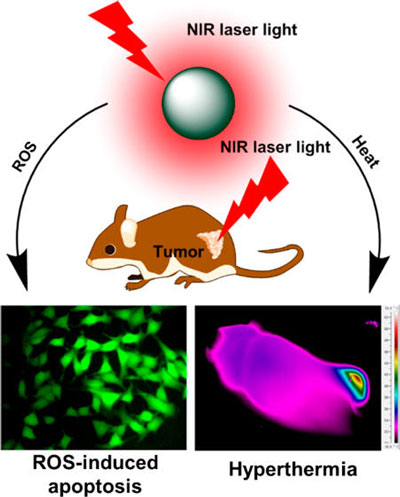| Posted: Feb 17, 2015 | |
Plasmonic nanocrystals for combined photothermal and photodynamic cancer therapies |
|
| (Nanowerk Spotlight) Photothermal therapy (PTT) is a form of cancer treatment where a therapeutic agent absorbs energy from photons and dissipates it partially in the form of heat. When the therapeutic agents, for instance nanoparticles, are located in close vicinity to the tumor site, the temperature increase can lead to cell damage, i.e. it kills the cancer cell. Research on PTT has made a huge progress thanks to various near-infrared light (NIR) absorbing – i.e. plasmonic – nanomaterials that have been developed in the past years. | |
| A similar approach uses light instead of heat and is called photodynamic therapy (PDT). This technique requires the use of a chemical compound – also known as photosensitizer – with a particular type of light to kill cancer cells. The photosensitizer in the tumor absorbs the light and generates reactive oxygen species (ROS) – such as hydroxyl radical, singlet oxygen, as well as peroxides – that destroy nearby cancer cells. | |
| While these techniques have been around for years, more recently the use of nanomaterials such as various forms of gold nanoparticles (rods, cages, spheres), quantum dots or iron-oxide nanoparticles has allowed researchers to refine their therapeutic methods with a view to also explore the mechanisms behind the efficacy. | |
| Scientists also developed combinations of nanomaterial-mediated PTT and organic photosensitizer-mediated PDT to achieve synergistic therapeutic effects. However, most of these approaches achieved only tumor suppression rather than complete destruction, especially under low laser dose conditions. | |
| Among the nanomaterials used, copper sulfide nanocrystals stand out because they can efficiently absorb near-infrared light at the 700-1100 nm range, which is considered as 'transparent' to human tissue at this energy level. Another reason that these plasmonic nanocrystals have attracted much attention as materials for PTT is their small size, which leads to the possibility of deeper tumor permeation. | |
| Previous reports have correlated photo induced cell death to the photothermal heat mechanism of copper sulfide nanocrystals, but no evidence of their photodynamic properties had been reported yet. | |
| In a new study, reported in the January 20, 2015 online edition of ACS Nano ("Plasmonic Copper Sulfide Nanocrystals Exhibiting Near-Infrared Photothermal and Photodynamic Therapeutic Effects"), an international team of researchers led by Drs. Teresa Pellegrino, Huan Meng, and Huiyu Liu, used abiotic assays, cultured cancer cells, and a melanoma animal model to demonstrate the PTT activity of copper sulfide nanocrystals. The paper lays out the working principle of colloidal, NIR plasmonic copper sulfide nanocrystals exploitable for both PDT and PTT therapy with NIR activation. | |
 |
|
| Schematic of the combined photothermal and photodynamic therapy. (Reprinted with permission by American Chemical Society) | |
| This is the first report that under a NIR light radiation copper sulfide nanocrystals (Cu2-xS) achieve efficient cancer destroying efficacy via PTT and PDT mechanisms both in vitro and in vivo. | |
| "Our findings demonstrated the dual functionalities of copper sulfide nanocrystals, which are capable of melanoma cancer inhibition under NIR irradiation via photothermal therapy and photodynamic therapy mediated mechanisms," Huiyu Liu, an Associate Professor at the Technical Institute of Physics and Chemistry, Chinese Academy of Sciences, tells Nanowerk. "This is the first report demonstrating that the leakage of copper ions from copper sulfide nanocrystals could enhance the ROS generation under NIR light irradiation, which serves as a new mechanism in addition to the sole PTT mechanism." | |
| Investigating the ROS generation mechanism, the researchers were able to show that the reduction of dissolved Cu2+ ions leads to Cu+ ions which further interact with the biological redox molecules, i.e. ascorbic acid and glutathione, and thus trigger the ROS generation. | |
| "Interestingly" Liu notes, "while we worked with a scenario involving nanoparticles, our theory behind the ROS generation is supported by a classic chemistry study, also known as Haber-Weiss cycle, proposed by Kadiiska et al. more than 20 years ago ("In vivo evidence of hydroxyl radical formation after acute copper and ascorbic acid intake: electron spin resonance spin-trapping investigation"). | |
| Based on the promising effect of photothermal therapies, the research team is confident that their dual functional Cu2-xS nanocrystals could lead to an even more potent platform for cancer treatment. | |
| "We are also considering to perform additional acute and chronic tests for our platform including the use of multiple melanoma animal models to confirm our findings in B16 murine model," says Liu. "Based on our proof-of-principle results, further studies are required to evaluate and optimize the PTT, or PDT, or dual functional platforms as we demonstrated in various cancer models, i.e. melanoma and head and neck carcinoma, with a view to also look at nanosafety in an acute and chronic phase." | |
| She adds that, from a manufacturing perspective, it is necessary to consider the scalability of nanomaterial production as well as quality control. | |
 By
Michael
Berger
– Michael is author of three books by the Royal Society of Chemistry:
Nano-Society: Pushing the Boundaries of Technology,
Nanotechnology: The Future is Tiny, and
Nanoengineering: The Skills and Tools Making Technology Invisible
Copyright ©
Nanowerk LLC
By
Michael
Berger
– Michael is author of three books by the Royal Society of Chemistry:
Nano-Society: Pushing the Boundaries of Technology,
Nanotechnology: The Future is Tiny, and
Nanoengineering: The Skills and Tools Making Technology Invisible
Copyright ©
Nanowerk LLC
|
|
|
Become a Spotlight guest author! Join our large and growing group of guest contributors. Have you just published a scientific paper or have other exciting developments to share with the nanotechnology community? Here is how to publish on nanowerk.com. |
|
